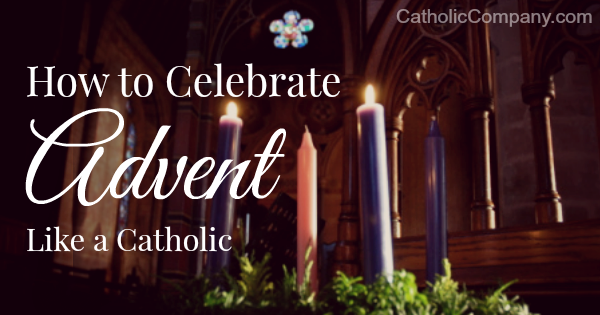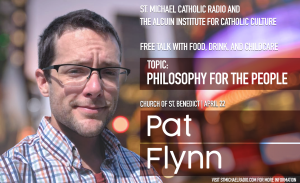What is Advent and what should Catholics do during Advent?

Does it seem to you that each year the holiday season gets busier and busier, and we get further and further away from the true meaning of the Advent and Christmas season?
The best way to combat this tendency is to adopt or renew Advent traditions in the home. Whether you are single, a busy parent with kids, or empty-nesters, you can celebrate Advent like you are actually anticipating the coming of Christ—which is the whole point. It’s a spiritual journey!
Remember the reason for the season; Advent and Christmas are Christian liturgical seasons. When you know what the season is meant to be, you will more likely do the kinds of things that emphasize that purpose.
First, some basics.
WHAT DOES ADVENT MEAN?
Advent derives from the Latin adventus meaning ‘arrival’ or ‘approach’. For thousands of years the world waited for the coming of the Messiah to redeem and to save the human race, restoring mankind’s relationship to God. We, too, experience this same longing for the coming of Christ. Spiritually, we long for the coming of Christ into our hearts as the Holy Spirit draws us into ever deepening relationship with Him; we also long for Christ in his Second Coming, when He will return physically to earth—as He promised—to restore all things to Himself.
Therefore the Advent season has these characteristics: it is a season of hopeful longing, joyful expectation, and prayerful preparation that looks to the past, the present, and the future. Advent connects us spiritually with God’s plan of redemption through Jesus Christ.
WHEN DOES ADVENT BEGIN?
Advent is the liturgical season we celebrate as the precursor to the Christmas season. Advent begins on the fourth Sunday before Christmas and ends on December 24th. Christmas begins December 25th at midnight and continues until the Feast of the Baptism of Jesus.
If you want to get the most out of Christmas and fill up your soul with love for Christ, the best way to do that is to “let every heart prepare Him room” —and celebrating Advent is the Church’s way to do it!
Listed below are 15 ways to celebrate Advent1 like a Catholic.
POPULAR ADVENT TRADITIONS
1. Advent Wreath: One of the most popular ways to celebrate Advent is with anAdvent wreath or Advent candleholders. Four candles (three purple and one pink), are used to count down the weeks until Christmas. Each Sunday of Advent one of the candles is lit and special prayers are said. Each Sunday of Advent has a particular theme leading up to the birth of Christ. Read more about the Advent Wreath Tradition and Meaning.
2. Advent Dinners: Make the Sundays of Advent into something special. Prepare a nice dinner or host a potluck and invite over family & friends. This would be a great time to light the candles on your Advent wreath and invite all to join in the special prayers for that week.
3. Prepare Seasonal Food: Many historically Catholic countries have traditions of preparing food that goes with the liturgical seasons, especially Advent and Christmas. Catholic bloggers are doing a great job of making these traditions more popular for all Catholics. Come up with something creative yourself or find inspiration on our Advent Ideas Pinterest Board.
4. Advent Devotional Reading: There are lots of great Advent books that take you deeper into the profound theology of Advent. God comes to us as a Child, and this is amazing to think about! Going through each day with devotional reading is one of the best ways to spiritually prepare yourself for Christmas, the birth of the King of Kings.
5. Special Prayers: Adopt special prayers during the Advent season. You can often find them in Advent devotional books. There is also the St. Andrew Christmas Novenawhich is traditionally prayed from the feast of St. Andrew (November 30th) until Christmas Eve.
Another tradition is praying the O Antiphons from the Liturgy of the Hours in the eight days leading up to Christmas. The O Antiphons are the antiphons of the Evening Prayers (Vespers) during the week before Christmas. Each antiphon welcome the birth of the Savior by heralding one of the resplendent Biblical titles of the soon-to-be-born Son of God as foreshadowed in the Old Testament by the prophet Isaiah.
6. Advent Calendars: Another popular way to celebrate the Advent season, especially popular with children, is the Advent calendar. Counting down the days to Christmas helps children to anticipate patiently and to focus on waiting for the baby Jesus to be born. You can purchase one, or make one as a fun craft time for kids.
7. Advent Music: Make your own playlist of music appropriate for Advent which anticipates Christ’s birth. Find a list of Advent music here.
8. Nativity Scenes: Nativity sets are a classic tradition and are great to display during the Advent season. To make the display especially poignant, wait until Christmas Eve to place the Baby Jesus into the scene. The Vatican has a neat tradition of the Holy Father blessing the Baby Jesus from family nativity scenes, called Bambinelli Sunday. This takes place on the third Sunday of Advent—Gaudete Sunday. Perhaps you could ask your parish priest to bless your Baby Jesus figure!

9. Jesse Tree: If you have kids,the Jesse Tree (named after the father of King David, the ancestor of Jesus, as mentioned in Isaiah 11) is a fun biblical activity during the Advent season which prepares for the birth of Christ and his mission. It’s fun for kids and great catechesis. It goes through the ancestry of Jesus and how all of his ancestors played a role in salvation history. The tree created can then be used as a holiday decoration.
10. Advent Penance Services: Advent is known as the “little Lent” and is therefore a time for penitential practices. Many Catholic parishes have special penance services for Advent. Confession is an important part of preparing room for the coming of Christ into our hearts, that is, allowing Him to draw us into deeper conversion.
11. Small Sacrifices for the Christ Child: Because Advent is known as the “little Lent,” prayer, alms, and sacrifices are also a also part of Advent season. Just as the Magi labored through a long journey to worship and gave precious gifts to the Christ Child, so we can do the same; we can give the Baby Jesus our sacrifices during the Advent season.
Adults can do this alone, but with kids a visual aid goes along well with the practice. Two popular ways are Jesus Stockings and a Jesus Creche. In both cases these small sacrifices are written on little slips of paper and placed into the stocking, or into or next to the empty creche in your nativity scene. These add up each day of Advent as birthday presents for the newborn King. When Jesus is born, and the baby Jesus is placed in the creche, the prayers and sacrifices have prepared Him room in our hearts. A beautiful visual!
12. Give: Good deeds and generosity have always been an important part of preparation for Christmas. Advent is a great time to practice spiritual and corporeal acts of mercy such as Christmas gifts for disadvantaged children, volunteering at a nursing home or soup kitchen, visiting the sick in a hospital, or simply inviting people into your home who may have no friends or family of their own to celebrate the holidays with. If you can’t find something to be a part of in your parish or local community, be an organizer for a cause you’re passionate about and get others involved.

13. Saint Feast Days: Celebrate the saints of the Advent & Christmas season. In addition to St. Andrew’s feast day on November 30th—the Advent kickoff— there are other saints with feast days during Advent that have special cultural traditions associated with them. St. Nicholas Day is on December 6th, the Feast of the Immaculate Conception (a Holy Day of Obligation) is December 8th, Our Lady of Guadalupe Feast Day is December 12th, and St. Lucy’s feast day is December 13th.
14. Christmas tree blessing: When you finish decorating the Christmas tree, bless it with this Christmas tree blessing from the USCCB.
15. Adopt a Cultural Tradition: There are also other Advent traditions that you can incorporate into your celebrations this year, such as the Oplatki Christmas wafer from Eastern Europe, and the La Posada introduced by missionary Augustinian friars in Latin American countries. La Posada is acted out as a play and recounts the difficult yet joyful journey of Mary and Joseph as they seek lodging for the birth of Jesus.

Hopefully these ideas have given you inspiration to celebrate Advent in a new and deeper way this year. If you have other ideas or family traditions, please comment below for our readers to enjoy. If you like these ideas, share this post with friends!
Original content from: A Catholic Company




